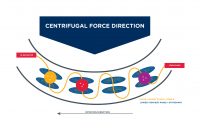Imagine this: you are taking medication for cancer pain. One day, it works perfectly. The next, you feel no relief. On some days, you need to take three doses just to get the same effect as one. Your doctor can’t be completely positive how much active ingredient each dose contains, so you decide for yourself how much medication to take.
Doesn’t seem safe, right? It is crucial that doctors know exactly what they are prescribing to their patients. They must know that their patients are receiving the exact same dose of medication in their prescription each time they take it, and that their medication contains only the intended ingredients.
consistency is key to creating products that are safe for consumers.In the cannabis industry, lack of certainty on these important factors is a major problem for drug manufacturers as they attempt to incorporate cannabidiol (CBD), a compound found in cannabis that has no psychoactive effects but many medical benefits, into pharmaceutical drugs.
When using these compounds as medications, purity is essential. Cannabis contains a wide variety of compounds. Delta-9 tetrahydrocannabinol (THC) is the most well-known compound and its main psychoactive one1. Safety regulations dictate that consumers know exactly what they are getting when they take a medication. For example, their CBD-based medications should not contain traces of THC.
The cannabis industry greatly needs a tool to ensure the consistent extraction and isolation of compounds. In 2017, the cannabis industry was worth nearly $10 billion, and it is expected to grow $57 billion more in the next decade2. As legalization of medical cannabis expands, interest in CBD pharmaceuticals is likely to grow.
If compounds such as CBD are going to be used in pharmaceutical drugs, consistency is key to creating products that are safe for consumers.
CBD’s Potential
CBD is a non-psychoactive compound that makes up 40 percent of cannabis extracts1. It is great for medical applications because it does not interfere with motor or psychological function. Researchers have found it particularly effective for managing cancer pain, spasticity in multiple sclerosis, and specific forms of epilepsy3.

Other compounds derived from cannabis, such as cannabichromene (CBC) and cannabigerol (CBG), may also be beneficial compounds with medical applications. CBC is known to block pain and inflammation, and CBG is known for its use as a potential anti-cancer agent1.
Along with these compounds that provide medical benefits, there are psychoactive compounds that are used recreationally, such as THC.
“It will definitely be an advantage to have cannabis-based medications with clearly defined and constant contents of cannabinoids,” says Kirsten Müller-Vahl, a neurologist and psychiatrist at Hannover Medical School in Germany.
Creating a Standard Through Centrifugal Partition Chromatography
To obtain purified compounds from cannabis, researchers need to use technology that will extract the compounds from the plant.
Many manufacturers use some sort of chromatography technique to isolate compounds. Two popular methods are high performance liquid chromatography (HPLC) and flash chromatography. These methods have their places in the field, but they cannot be effectively and cost-efficiently scaled to isolate compounds. Instead, HPLC and flash chromatography may be better suited as analytical tools for studying the characteristics of the plant or extract. As cannabis has more than 400 chemical entities4, compound isolation is an important application.
This method is highly effective for achieving both high purity and recovery.Although molecules such as CBD can be synthesized in the lab, many companies would rather extract the compounds directly from the plant. Synthesized molecules do not result in a completely pure compound. The result, “is still a mixture of whatever cannabinoids are coming from a particular marijuana strain, which is highly variable,” says Brian Reid, chief scientific officer of ebbu, a company in Colorado that specializes in cannabis purification.
Currently, there is only one method available to researchers that completely allows them to isolate individual compounds: centrifugal partition chromatography (CPC).
The principle of CPC is similar to other liquid chromatography methods. It separates the chemical substances as the compounds in the mobile phase flow through and differentially interact with the stationary phase.
Where CPC and standard liquid chromatography differs is the nature of the stationary phase. In traditional chromatography methods, the stationary phase is made of silica or other solid particles, and the mobile phase is made of liquid. During CPC, the stationary phase is a liquid that is spun around or centrifuged to stay in place while the other liquid (mobile phase) moves through the disc. The two liquid phases, like oil and water, don’t mix. This method is highly effective for achieving both high purity and recovery. Chemists can isolate chemical components at 99 percent or higher purity with a 95 percent recovery rate5.
“CPC is ideal for ripping a single active ingredient out of a pretty complex mixture,” says Reid. “It’s the only chromatographic technique that does that well.”
The Need for Pure Compounds
High levels of purity and isolation are necessary for cannabis to be of true value in the pharmaceutical industry. Imagine relying on a medication to decrease your seizures, and it has a different effect every time. Sometimes there may be traces of psychoactive compounds. Sometimes there are too much or too little of the compound that halts your seizures. This is not a safe practice for consumers who rely on medications.“It’s hard to do studies on things you can’t control very well.”
Researchers working with cannabis desperately need a technology that can extract compounds with high purity rates. It is hard to run a study without knowing the precise amounts of compounds used. Reid uses a Gilson CPC 1000 system at ebbu for his cannabinoid research. With this technology, he can purify cannabinoids for his research and create reliable formulations. “Now that we have this methodology dialed in we can make various formulations —whether they’re water-soluble, sublingual, inhaled, you name it —with very precise ratios of cannabinoids and precise amounts of cannabinoids at the milligram level,” says Reid.
Kyle Geary, an internist at the University of Illinois at Chicago, is currently running a placebo-controlled trial of CBD capsules for Crohn’s disease. This consistent isolation is helpful for his research, as well. “Ideally, the perfect study would use something that is 100 percent CBD,” says Geary. “It’s hard to do studies on things you can’t control very well.”
The State of the Industry
While CBD is not considered a safe drug compound under federal law in the United States6, 17 states have recently passed laws that allow people to consume CBD for medical reasons7. Half of medicinal CBD users solely use the substance for treatment, a recent survey found8. As the industry quickly grows, it is crucial that consumer safety protocol keeps pace.
In June, the US Food and Drug Administration (FDA) approved the first drug that contains a purified drug substance from cannabis, Epidiolex9. Made from CBD, it is designed to treat Dravet Syndrome and Lennox-Gastaut syndrome, two rare forms of epilepsy. FDA Commissioner Scott Gottlieb said in the news release that although the FDA will work to support the development of high-quality cannabis-based products moving forward, “We are prepared to take action when we see the illegal marketing of CBD-containing products with serious, unproven medical claims. Marketing unapproved products, with uncertain dosages and formulations can keep patients from accessing appropriate, recognized therapies to treat serious and even fatal diseases.”
The industry should be prepared to implement protocols to ensure the quality of their CBD-based products. The FDA has issued warnings in recent years that some cannabinoid products it has tested do not contain the CBD levels their makers claim, and consumers should be wary of such products10. It’s hard to know when or if the FDA will begin regulating CBD-based pharmaceuticals. However, for pharma companies serious about their reputation, there is only one isolation method that creates reliable product quality: CPC.
References:
- Lab Manager. (2018, January 3). Cannabinoid Chemistry Infographic. Retrieved from http://www.labmanager.com/multimedia/2017/07/cannabinoid-chemistry-infographic#.WzT2e1MvyMI
- BDS Analytics. (2018, February 26). NEW REPORT: Worldwide spending on legal cannabis will reach $57 billion by 2027. Retrieved from https://bdsanalytics.com/press/new-report-worldwide-spending-on-legal-cannabis-will-reach-57-billion-by-2027/
- National Institute on Drug Abuse. (2015, June 24). The Biology and Potential Therapeutic Effects of Cannabidiol. Retrieved from https://www.drugabuse.gov/about-nida/legislative-activities/testimony-to-congress/2016/biology-potential-therapeutic-effects-cannabidiol
- Atakan, Z. (2012). Cannabis, a complex plant: Different compounds and different effects on individuals. Therapeutic Advances in Psychopharmacology,2(6), 241-254. doi:10.1177/2045125312457586
- Gilson. (n.d.). Centrifugal Partition Chromatography (CPC) Systems. Retrieved from http://www.gilson.com/en/AI/Products/80.320#.WzVB2lMvyMI
- Mead, A. (2017). The legal status of cannabis (marijuana) and cannabidiol (CBD) under US law. Epilepsy & Behavior, 70, 288-291.
- ProCon.org. (2018, May 8). 17 States with Laws Specifically about Legal Cannabidiol (CBD) – Medical Marijuana – ProCon.org. Retrieved from https://medicalmarijuana.procon.org/view.resource.php?resourceID=006473
- Borchardt, D. (2017, August 03). Survey: Nearly Half Of People Who Use Cannabidiol Products Stop Taking Traditional Medicines. Retrieved from https://www.forbes.com/sites/debraborchardt/2017/08/02/people-who-use-cannabis-cbd-products-stop-taking-traditional-medicines/#43889c942817
- U.S. Food & Drug Administration. (2018, June 25). Press Announcements – FDA approves first drug comprised of an active ingredient derived from marijuana to treat rare, severe forms of epilepsy. Retrieved from https://www.fda.gov/NewsEvents/Newsroom/PressAnnouncements/ucm611046.htm
- U.S. Food & Drug Administration. (2017). Public Health Focus – Warning Letters and Test Results for Cannabidiol-Related Products. Retrieved from https://www.fda.gov/newsevents/publichealthfocus/ucm484109.htm







